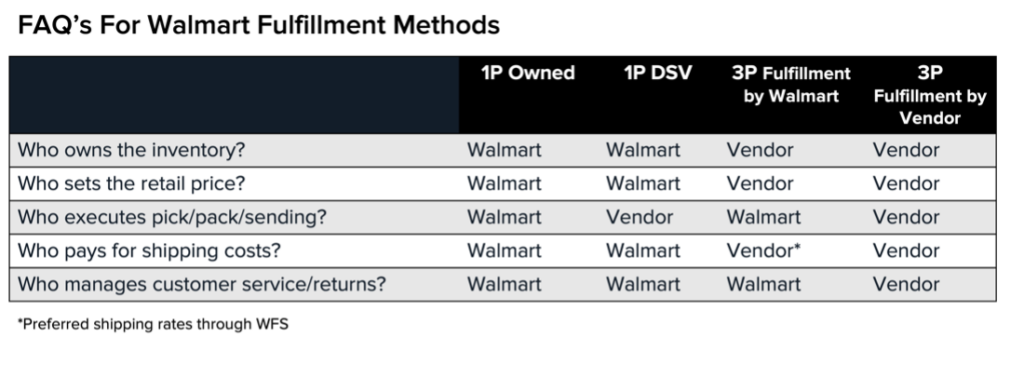Listing products on Walmart Marketplace is becoming increasingly important as Walmart continues to make investments in eCommerce. Many Merchants are encouraging Suppliers to be active on Walmart Marketplace. However, discerning what Walmart fulfillment method makes the most sense for your assortment is not always easy, and the answer often varies by item.
For most traditional vendors in the Walmart ecosystem, selling 1P is usually preferable and is often the primary goal. However, Walmart is sending more and more vendors to their Marketplace platform to list long-tail items in their portfolio, as well as using Marketplace as a testing ground for new items.
Further, more and more non-traditional sellers are getting into the Walmart.com game, listing products on Marketplace, similarly to how they’ve been listing items in other 3P Marketplaces, like Amazon, for many years.
So, whether you’re seeking to get Walmart to commit to a 1P listing, or whether you’re looking to best leverage the Walmart Marketplace platform, the first step is understanding all the possible methods of inventory ownership and Walmart fulfillment options in the Walmart.com ecosystem before deciding which is the best fit for your product. Answering questions like the following will help any vendor or seller find the best path forward.
- Can I fulfill DTC orders from my warehouse?
- Can I profitably sell via Walmart Fulfillment Services?
- Am I concerned about controlling the retail price on Walmart.com?
FAQ’s for Walmart Fulfillment Methods

1P Owned Inventory
This is the traditional model of mass retail. Suppliers receive POs from Walmart and ship pallets with thousands of units to various Walmart Distribution Centers around the country. Walmart has officially purchased the inventory from the vendor at a set cost and stores the inventory in their warehouse. From there, Walmart picks, packs, and ships each Walmart.com order to the consumer from their own warehouse.
1P DSV
When vendors have the capability to ship directly to consumers from their own warehouses, Walmart can leverage the “Drop Ship Vendor” format to save on inventory space in their Distribution Centers while still purchasing inventory like in a more traditional 1P relationship. In this model, Walmart purchases the inventory from the vendor by unit at the point of sale. The minute a customer purchases something online, Walmart “buys” the product from the vendor for a set cost, regardless of the retail at which the customer purchased the product.
In this model, Walmart still “owns” the inventory being sold and thus sets the price. However, they do not take on the inventory, but allow the inventory to remain at the vendor’s warehouse. When a customer makes a purchase, Walmart relays that customer’s information to the vendor, who is responsible to pick, pack, and ship the product to the customer.
The costs associated with storing inventory, picking, and packing all fall to the vendor, but the vendor uses a pre-shared Walmart shipping account (via USPS, FedEx, or UPS) to ship to the customer, so that Walmart covers the cost of freight to get the product to the customer instead of the vendor. Because vendors are bearing the costs of inventory holding, picking, and packing, there is usually a slightly higher cost to Walmart for a DSV item than for a traditional 1P Owned Inventory item.
3P Fulfillment by Walmart
If Walmart does not want to take ownership of the inventory at all, the next best option will be for vendors to use “Fulfillment by Walmart” in the 3P Marketplace. In this model, vendors retain ownership of the product all the way to the point of sale. Walmart never actually purchases the product, but it does take a commission or “referral fee” on every transaction, usually between 8% and 15%. Vendors ship units into Walmart’s fulfillment centers on consignment, rent the space they are using, and pay Walmart a consistent fee to pick, pack, and ship their product for them every time a customer orders their item.
Because Walmart is managing the picking, packing, and shipping of the product, vendors don’t have to invest in DTC shipping capability in their own warehouses, however, they will need to pay the fees associated with Walmart managing this on their behalf.
A full list of associated fees and a per-unit fee calculator can be found here. Vendors will need to calculate whether they can sell profitably through WFS after paying the referral fee, the monthly storage fee, and item-level fulfillment costs.
3P Fulfillment by Vendor
If your retail price won’t support profitability after the WFS fees come together, the last option would be for a vendor to forgo Walmart Fulfillment Services and choose fulfillment by vendor.
In this model, the vendor owns the inventory, sets the price, and manages all the shipping (picks, packs, and ships products directly to consumers). Walmart’s only role in the sale is allowing the seller to list items on their website and providing customers to buy them.
In return for a spot on the site, Walmart only takes a “referral fee” or commission on the retail sale price. Most categories are at 15%, with select categories as low as 8%. Everything is owned by the vendor, who must have the in-house capability or contract with a 3PL to send goods directly to consumers.
How Should I Sell My Product?
Ultimately, how you sell your items all depends on your goals for your relationship with Walmart and for profitability. If you are a traditional vendor already doing business with Walmart and your cost structures are solid, you’ll probably want to target 1P or DSV, wherein Walmart pays you a set cost for each unit. However, if Walmart is unwilling to take your product for 1P/DSV and asks you to list the product on the marketplace, you will need to calculate whether WFS or 3P Fulfillment by Vendor will ultimately be more profitable for you, depending on the weight and size of your items and your ability to ship items.
A good rule of thumb is that anything that won’t fit in a small shipping envelope and retails for less than $10 is probably a non-starter. Low-weight items with retail prices above $15 begin can typically produce a profitable sale, but for heavier items, higher retail prices will be required to make the economics work. Brands should also consider the cost/fee differences between managing to ship themselves or leveraging WFS. Refer again to the cost calculator provided by Walmart to understand the costs of WFS and compare those to other options.
Here is a decision flowchart we’ve created to help guide your process:

A few additional things to keep in mind with your Walmart Marketplace listings:
- Walmart Marketplace does compare item pricing on other sites like Amazon and Target. If your price on Walmart.com is too high compared to the rest of the market, Walmart may not feature your buy box or could suppress the listing altogether.
- Sales conversions drop when a listing is labeled “Sold and shipped by [third party name]” versus “Sold and shipped by Walmart.com”. A major benefit in going through Walmart Fulfillment services is to have the “Sold and shipped by Walmart.com” badge to increase sales conversion.
- Be sure to calculate all costs involved when looking at Walmart Fulfillment services or any other third-party solution. You will pay to ship product to their facilities; you will pay to use their facilities to store your product; you will pay them to pick, pack, and ship the product for you; and you will also pay Walmart’s referral fee. Also, storage fees are liable to increase if your product sits in Walmart’s FCs for more than 30 days. Slow turns = higher fees.
The decision to sell on Walmart Marketplace seems convoluted but can be fairly clear-cut once you do the front-end math. Not every item will support the economics of Walmart Marketplace, and proactive vendors need to know what they are getting into before they waste time listing products and shipping inventory. While Merchants might be pointing vendors to the Marketplace as a solution for long-tail assortment, there are no silver bullets in retail and this road has its own hurdles to contend with.
If you’re looking for expertise for your Walmart.com assortment, our Harvest Group team of Walmart omnichannel experts would be happy to set up an initial consultation call with your team. Reach out to us at hello@harvestgroup.com or fill out our Contact Us form here.


